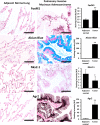FOXM1 activates AGR2 and causes progression of lung adenomas into invasive mucinous adenocarcinomas
- PMID: 29267283
- PMCID: PMC5755924
- DOI: 10.1371/journal.pgen.1007097
FOXM1 activates AGR2 and causes progression of lung adenomas into invasive mucinous adenocarcinomas
Abstract
Lung cancer remains one of the most prominent public health challenges, accounting for the highest incidence and mortality among all human cancers. While pulmonary invasive mucinous adenocarcinoma (PIMA) is one of the most aggressive types of non-small cell lung cancer, transcriptional drivers of PIMA remain poorly understood. In the present study, we found that Forkhead box M1 transcription factor (FOXM1) is highly expressed in human PIMAs and associated with increased extracellular mucin deposition and the loss of NKX2.1. To examine consequences of FOXM1 expression in tumor cells in vivo, we employed an inducible, transgenic mouse model to express an activated FOXM1 transcript in urethane-induced benign lung adenomas. FOXM1 accelerated tumor growth, induced progression from benign adenomas to invasive, metastatic adenocarcinomas, and induced SOX2, a marker of poorly differentiated tumor cells. Adenocarcinomas in FOXM1 transgenic mice expressed increased MUC5B and MUC5AC, and reduced NKX2.1, which are characteristics of mucinous adenocarcinomas. Expression of FOXM1 in KrasG12D transgenic mice increased the mucinous phenotype in KrasG12D-driven lung tumors. Anterior Gradient 2 (AGR2), an oncogene critical for intracellular processing and packaging of mucins, was increased in mouse and human PIMAs and was associated with FOXM1. FOXM1 directly bound to and transcriptionally activated human AGR2 gene promoter via the -257/-247 bp region. Finally, using orthotopic xenografts we demonstrated that inhibition of either FOXM1 or AGR2 in human PIMAs inhibited mucinous characteristics, and reduced tumor growth and invasion. Altogether, FOXM1 is necessary and sufficient to induce mucinous phenotypes in lung tumor cells in vivo.
Conflict of interest statement
The authors have declared that no competing interests exist.
Figures








References
-
- Travis WD, Brambilla E, Noguchi M, Nicholson AG, Geisinger K, Yatabe Y, et al. International Association for the Study of Lung Cancer/American Thoracic Society/European Respiratory Society: international multidisciplinary classification of lung adenocarcinoma: executive summary. Proc Am Thorac Soc. 2011;8(5):381–5. doi: 10.1513/pats.201107-042ST . - DOI - PubMed
-
- Jagirdar J. Application of immunohistochemistry to the diagnosis of primary and metastatic carcinoma to the lung. Arch Pathol Lab Med. 2008;132(3):384–96. doi: 10.1043/1543-2165(2008)132[384:AOITTD]2.0.CO;2 . - DOI - PubMed
-
- Maeda Y, Tsuchiya T, Hao H, Tompkins DH, Xu Y, Mucenski ML, et al. Kras(G12D) and Nkx2-1 haploinsufficiency induce mucinous adenocarcinoma of the lung. J Clin Invest. 2012;122(12):4388–400. doi: 10.1172/JCI64048 ; PubMed Central PMCID: PMC3533546. - DOI - PMC - PubMed
-
- Winslow MM, Dayton TL, Verhaak RG, Kim-Kiselak C, Snyder EL, Feldser DM, et al. Suppression of lung adenocarcinoma progression by Nkx2-1. Nature. 2011;473(7345):101–4. doi: 10.1038/nature09881 ; PubMed Central PMCID: PMC3088778. - DOI - PMC - PubMed
-
- Hwang DH, Sholl LM, Rojas-Rudilla V, Hall DL, Shivdasani P, Garcia EP, et al. KRAS and NKX2-1 Mutations in Invasive Mucinous Adenocarcinoma of the Lung. J Thorac Oncol. 2016;11(4):496–503. doi: 10.1016/j.jtho.2016.01.010 . - DOI - PubMed
Publication types
MeSH terms
Substances
Grants and funding
LinkOut - more resources
Full Text Sources
Other Literature Sources
Medical
Molecular Biology Databases
Miscellaneous

